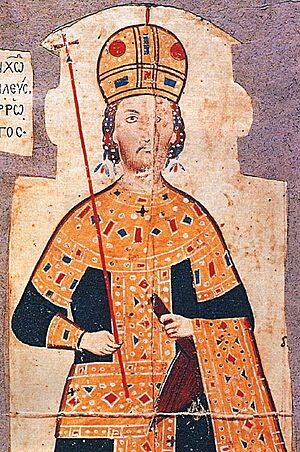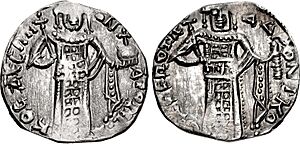Andronikos III Palaiologos facts for kids
Quick facts for kids Andronikos III Palaiologos |
|||||
|---|---|---|---|---|---|
| Emperor and Autocrat of the Romans | |||||

|
|||||
| Byzantine emperor | |||||
| Reign | 24 May 1328 – 15 June 1341 | ||||
| Coronation | 2 February 1325 | ||||
| Predecessor | Andronikos II Palaiologos | ||||
| Successor | John V Palaiologos | ||||
| Proclamation | 1308/1313 as co-emperor | ||||
| Born | 25 March 1297 Constantinople, Byzantine Empire (now Istanbul, Turkey) |
||||
| Died | 15 June 1341 (aged 44) Constantinople, Byzantine Empire |
||||
| Spouse | Irene of Brunswick Anna of Savoy |
||||
| Issue more... |
Irene, Empress of Trebizond Maria (renamed Irene) John V Palaiologos Michael Palaiologos |
||||
|
|||||
| House | Palaiologos | ||||
| Father | Michael IX Palaiologos | ||||
| Mother | Rita of Armenia | ||||
| Religion | Eastern Orthodox | ||||
Andronikos III Palaiologos (born 25 March 1297 – died 15 June 1341) was the Byzantine emperor from 1328 to 1341. He was the son of Michael IX Palaiologos and Rita of Armenia. He became co-emperor when he was young, before 1313. In April 1321, he started a rebellion against his grandfather, Andronikos II Palaiologos.
Andronikos III was officially crowned co-emperor in February 1325. He then took over completely, becoming the sole emperor on 24 May 1328. During his rule, he tried to stop the growing power of the Ottoman Turks. He also fought against the Bulgarians at the Battle of Rusokastro. However, he also managed to take back several important places like Chios, Lesbos, Phocaea, Thessaly, and Epirus. His early death led to a difficult civil war that weakened the Byzantine Empire even more.
Contents
Life of Andronikos III
Andronikos was born in Constantinople (today's Istanbul) on 25 March 1297. His father, Michael IX Palaiologos, was already ruling as a co-emperor around 1295.
In March 1318, Andronikos married Irene of Brunswick. She was the daughter of Henry I, Duke of Brunswick-Grubenhagen. Around 1321, they had a son who sadly died as a baby.
In 1320, Andronikos accidentally caused the death of his brother, Manuel. His father, Michael IX, was so sad that he also died. This accident, along with some other issues, caused a big problem between young Andronikos and his grandfather, Emperor Andronikos II Palaiologos.
Emperor Andronikos II was very upset with his grandson. Andronikos III left the capital city and gathered his supporters in Thrace. He began to rule as a rival emperor in 1321. A few months later, Andronikos II agreed to name Andronikos III as his co-emperor. However, this didn't stop a civil war from happening between the two emperors from 1321 to 1328.
Empress Irene died in August 1324, and she had no surviving children. Andronikos III's sister, Theodora Palaiologina, married the new Bulgarian tsar Michael Shishman of Bulgaria in 1324. As a widower, Andronikos III married Anna of Savoy in October 1326. In 1327, they had a daughter named Maria, who was later renamed Irene.
Andronikos III made an agreement called the Treaty of Chernomen in 1327. This was an alliance with Tsar Michael Shishman of Bulgaria against Stephen Uroš III Dečanski of Serbia. In 1328, the Byzantine civil war finally ended. Emperor Andronikos II was removed from power and went to live in a monastery.
Andronikos III's Reign
Military Actions
The Ottoman Turks were growing stronger and had surrounded Nicaea in Asia Minor. This city was once the temporary capital of the Byzantine Empire. Andronikos III tried to help Nicaea, but the Ottoman sultan Orhan defeated his army at the Battle of Pelekanon in June 1329.
Also in 1329, Andronikos III sent his navy to fight Martino Zaccaria. He was a ruler from Genoa who controlled the island of Chios, along with Samos and Cos. The Byzantine navy won, removing Zaccaria and bringing the islands back under Byzantine control.
An alliance with Bulgaria didn't help the Byzantine Empire much. On 28 July 1330, the Serbians strongly defeated the Bulgarians in the Battle of Velbazhd. The Byzantines didn't play a big part in this battle. The Ottomans kept advancing, finally taking Nicaea in 1331. Andronikos III wanted to protect Nicomedia and other Byzantine forts in Anatolia. He tried to pay the Ottomans a tribute to keep them away.
Andronikos III worked to make the Byzantine navy stronger. By 1332, it only had 10 ships, but in emergencies, he could gather about a hundred extra merchant ships to help.
After failing to gain much against Serbia, Andronikos III tried to take over parts of Bulgarian Thrace. However, the new Bulgarian tsar Ivan Alexander of Bulgaria defeated the Byzantine forces at the Battle of Rusokastro on 18 July 1332. Andronikos III made peace with Bulgaria by giving up some land. His daughter Maria (renamed Irene) also married Ivan Alexander's son, who would become Michael Asen IV of Bulgaria.
The Muslim traveler Ibn Battuta visited Constantinople around 1332. He wrote in his travel stories that he met Andronikos III. However, Byzantine records don't mention this meeting.
When Stephen Gabrielopoulos, the ruler of Thessaly, died around 1333, Andronikos III took advantage of the situation. He expanded Byzantine control over that region.
Syrgiannes Palaiologos, who was in charge of Thessalonica, switched sides and joined King Stephen Uroš IV Dušan of Serbia. He helped the Serbs advance into Macedonia. The Serbs soon took control of Ohrid, Prilep, and Strumitsa. Syrgiannes then helped capture Kastoria, and the Serbs marched towards Thessalonica, reaching its walls.
The Byzantines responded with a clever plan. A Byzantine general named Sphrantzes Palaiologos pretended to switch sides. He entered the Serbian camp and killed Syrgiannes Palaiologos. This greatly upset Dušan's plans, as his successes were mostly thanks to Syrgiannes's skills and knowledge. Dušan also heard that the Byzantines had just pushed back a large Turkish raiding party, freeing up more troops for Thessalonica. He also learned that Hungarians were preparing to attack Serbia from the north. Because of this, the Serbs agreed to peace on 26 August 1334. The Byzantines recognized Serbian control over Ohrid, Prilep, Strumitsa, and other areas.
Andronikos III also managed to take back Phocaea in 1334 from its last Genoese governor, Domenico Cattaneo. But this victory didn't stop the Ottomans from advancing in Asia Minor. Byzantine rule slowly disappeared from Anatolia. Paying tribute didn't stop Ottoman sultan Orhan, who took Nicomedia in 1337. Only Philadelphia and a few ports remained under Byzantine control.
Despite these problems, Andronikos III took advantage of a leadership crisis in the Despotate of Epirus in 1337. He brought Epirus back under Byzantine control from Nikephoros II Orsini. Thessaly was also re-conquered by Andronikos III during this time.
In 1340, Dušan became very ill. At this important time, one of Dušan's main commanders, Hrelja, left the Serbs and joined the Byzantines. He could do this because he owned lands right on the Byzantine-Serbian border, including the area around the Struma river, with Strumitsa and two other strong castles nearby.
In 1341, the Latin lords of the Peloponnese sent a group to Constantinople. They wanted to promise their loyalty to the Byzantine emperor. Andronikos III, who was ill, met with them shortly before he died on 15 June 1341.
Domestic Policies
John Kantakouzenos, who was a very important official and later became emperor himself, handled much of the government during Andronikos III's reign. The Emperor himself enjoyed hunting and leading his armies.
Andronikos III also made changes to the legal system. He created a group of four judges called "Universal Justices of the Romans" to improve how justice was given.
Family
Andronikos III first married Irene of Brunswick in 1318. She was the daughter of Henry I, Duke of Brunswick-Lüneburg. She died in 1324. They had a son who died soon after birth in 1321.
In 1326, Andronikos III married his second wife, Anna of Savoy. She was the daughter of Amadeus V, Count of Savoy. They had several children, including:
- Maria (later renamed Eirene) Palaiologina, who married Michael Asen IV of Bulgaria.
- John V Palaiologos (born 18 June 1332).
- Michael Palaiologos, who was named as a future ruler.
- Irene (later renamed Maria) Palaiologina, who married Francesco I Gattilusio.
According to a historian from that time, Nicephorus Gregoras, Andronikos also had a daughter who was not born in marriage. Her name was Irene Palaiologina of Trebizond. She married Emperor Basil of Trebizond and ruled the Empire of Trebizond from 1340 to 1341. Another traveler, Ibn Battuta, also wrote about another daughter. She married Öz Beg Khan of the Golden Horde, became a Muslim, and took the name Bayalun. Ibn Battuta said he traveled with her to Constantinople in 1332 or 1334.
Succession and Legacy
Andronikos III died in Constantinople on 15 June 1341, when he was 44 years old. He might have died from a long-term illness like malaria. He was buried in the Hodegon Monastery. Historians believe that when he died, the Byzantine Empire was still in a manageable state. They generally don't blame his leadership for its later decline. His son, John V Palaiologos, became the next Byzantine emperor. However, John was only nine years old, so he needed someone to rule for him.
Emperor Andronikos III was very active in his military campaigns. But his empire simply wasn't strong enough to completely defeat its enemies. He faced several important losses against the Bulgarians, Serbians, and Ottomans. Still, Andronikos III was an active leader and worked well with skilled government officials. Under his rule, the empire came closest to regaining its power in the Balkans and the Greek peninsula after the Fourth Crusade. However, losing some imperial lands in Anatolia meant the Ottoman Turks were ready to expand into Europe.
Just a few months after Andronikos III died, a disagreement broke out. People argued over who should rule for the young Emperor John V Palaiologos. They also argued about the powerful position of John Kantakouzenos, who was Andronikos's chief minister and friend. This led to a very damaging civil war. This war used up the empire's resources and left it in a very weak state. The weakened Byzantine Empire could not stop the formation of the Serbian Empire. Even more seriously, it couldn't prevent the Ottoman invasion of Europe.
See also
 In Spanish: Andrónico III Paleólogo para niños
In Spanish: Andrónico III Paleólogo para niños


